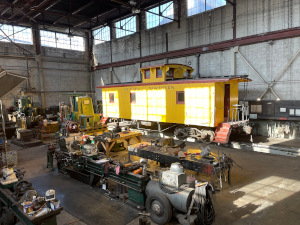Today it was so cold that the ice on Jose didn't melt in the sun. Instead, it became dry  Restored caboose
enough that the windshield wipers brushed it right off. At our hotel, the front desk manager, who had immigrated to Northern Nevada from Poland twenty years ago, tried to explain that her childhood home was about as cold in the winter as Ely is - "in the minus tens - that's Celsius."
Restored caboose
enough that the windshield wipers brushed it right off. At our hotel, the front desk manager, who had immigrated to Northern Nevada from Poland twenty years ago, tried to explain that her childhood home was about as cold in the winter as Ely is - "in the minus tens - that's Celsius."
The wonderfully scenic drive through parts of the Great Basin was even emptier than we had found before. Occasional signs alerted drivers to deer, elk, and antelope migrations but we saw none. We spotted several ranches, widely scattered in the foothills, but saw no activity. We drove past a couple of settlements which looked close to collapsing entirely. The Drugstore Museum in McGill was closed; in fact most of the stores in town were boarded up.
The scenery, however, was spectacular, partly because just enough snow remains from  Four of eleven locomotives
last week's blizzard that little pockets of brilliant white peek out from bushes along the road, and the mountains on both sides of the road seem snow covered, until seen up close they only have a dusting of snow left.
Four of eleven locomotives
last week's blizzard that little pockets of brilliant white peek out from bushes along the road, and the mountains on both sides of the road seem snow covered, until seen up close they only have a dusting of snow left.
Much traffic is large commercial trucks.
In Ely, we visited the Northern Nevada Railroad Museum. It's a delightful place. The historian we spoke with told us that the large open pit copper mine which closed shortly after 1980, taking most of the town's jobs away, lowered the morale of the place. But a  Railroad handcar
group of local people decided to use the trains which had served the mine, and the buildings which supported the trains, to be a public historical museum; the Kennecott copper company was persuaded to donate their railroad property to the town on condition that it be a public museum with proper plans for continuing growth and maintenance. Now a municipal corporation directs operations.
Railroad handcar
group of local people decided to use the trains which had served the mine, and the buildings which supported the trains, to be a public historical museum; the Kennecott copper company was persuaded to donate their railroad property to the town on condition that it be a public museum with proper plans for continuing growth and maintenance. Now a municipal corporation directs operations.
When Kennecott closed down, they left everything behind (rather like the Navy closing a military base). Visitors can see a time capsule-like display of office supplies, a giant ledger of daily transactions, and stationery from forty years ago. The most popular building is the Operations building, which restores and maintains the rolling stock, which includes at least eleven locomotives. All of this work is supervised by the Station cat, a  A cat named Dirt
tabby named Dirt.
A cat named Dirt
tabby named Dirt.
In late Spring and summer, the museum hosts train rides and in winter they run the Polar Express. You can learn and get a certificate to drive a locomotive for a few miles on real, live track. It costs almost $900 and requires taking a short course, but if you stick to riding as a passenger it's quite reasonable.
We are staying one night at the Nevada Hotel, the tallest hotel in Ely, built in the 1920s (at which time it was the tallest building in Nevada) and being restored to its former glory. Our room is on the top floor, a suite in a series named for movie stars who might have stayed here in the boom times. Restoration is still underway, but we have stayed in so many hotels we are accustomed to minor imperfections. As always, though, the people who are actually working in the businesses we meet, like the hotels and shops and museums, are unfailingly pleasant and helpful and happy to talk about their hometown.
 Restored caboose
enough that the windshield wipers brushed it right off. At our hotel, the front desk manager, who had immigrated to Northern Nevada from Poland twenty years ago, tried to explain that her childhood home was about as cold in the winter as Ely is - "in the minus tens - that's Celsius."
Restored caboose
enough that the windshield wipers brushed it right off. At our hotel, the front desk manager, who had immigrated to Northern Nevada from Poland twenty years ago, tried to explain that her childhood home was about as cold in the winter as Ely is - "in the minus tens - that's Celsius."
 Four of eleven locomotives
Four of eleven locomotives Railroad handcar
Railroad handcar A cat named Dirt
A cat named Dirt